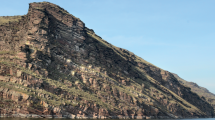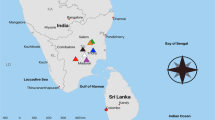Abstract
The occurrence of a sub-aerial microbial community dominated by a species ofTrentepohlia, a red-orange pigmented filamentous green alga, growing on a 13th century sandstone building in the Scottish borders appears to be associated with unusual stone decay. Decay, in the form of extensive surface spalling and grain dissagregation over large areas of external stonework, are coincident with the distribution of the algal community on the north facade of the building. Comparison of S.E.M. images taken of fresh intact stone and spalled stone from decayed zones suggests that the mechanisms of decay may, in part, be a physical process which results in quartz crystals becoming separated. The investigations carried out revealed little evidence of chemical processes which may be involved in the decay. Large filaments ofTrentepohlia are clearly visible growing vertically between separate grains of stone and the amount of highly absorbent mucilage present makes the friable dry spall become soft and gelatinous on wetting. It is possible that the observed decay may have been created through the mechanical action of wet-dry cycling of mucilage and expansive stress from the growth of algal filaments.
Similar content being viewed by others
References
Belcher, H. and Swale, E. (1978) Freshwater Algae — A Beginner's Guide. Institute of Terrestrial Ecology, NERC. HMSO, London, pp. 22–23.
Bock, E. and Sand, W. (1993) The microbiology of masonry biodeterioration. J. Appl. Bacteriol. 74, 503–514.
Caneva, G., Nugari, M.P., Ricci, S. and Salvadori, O. (1993) Pitting of marble Roman monuments and the related microflora. In: Proceedings of the 7th International Congress ‘Deterioration and Conservation of Stone’, Lisbon, Portugal, 1992, pp. 521–530.
Danin, A. and Caneva, G. (1990) Deterioration of limestone walls in Jerusalem and marble monuments in Rome caused by cyanobacteria and cyanophilous lichens. Int. Biodeter. 26, 397–417.
Eckhardt, F.E.W. (1985) Solubilisation, transport and deposition of mineral cations by microorganism — efficient rock weathering agents. In: J.I. Drever (Ed.), The Chemistry of Weathering. Reidel, Dordrecht, pp. 161–173.
Griffin, P.S., Indictor, N. and Koestler, R.J. (1991) The biodeterioration of stone: a review of deterioration mechanisms, conservation case histories, and treatment. Int. Biodeter. 28, 187–207.
Hueck-van der Plas, E.H. (1968) The micro-biological deterioration of porous building materials. Int. Biodeter. Bull. 4, 11–28.
Jones, M.S. (1990) The Degradation of Building Stone, Ph.D. Thesis, UMIST.
Jones, D. and Wilson, M.J. (1985) Chemical activities of lichens on mineral surfaces: a review. Int. Biodeter. 22, 99–104.
Koestler, R.J., Charola, A.E., Wypyski, M. and Lee, J.J. (1985) Microbiologically induced deterioration of dolomitic and calcitic stone as viewed by scanning electron microscopy. In: Proceedings of the Vth International Congress ‘Deterioration and Conservation of Stone’. Lausanne, 1985, pp. 617–626.
Krumbein, W.E. and Dyer, B.D. (1985) This planet is alive — weathering and biology, a multi-facetted problem. In: J.I. Drever (Ed.), The Chemistry of Weathering. Reidel, Dordrecht, pp. 143–160.
Krumbein, W.E. and Lange, C. (1978) Decay of plaster, paintings and wall material of the interior of buildings via microbial activity. In: W.E. Krumbein (Ed.), Environmental Biogeochemistry and Geomicrobiology. Ann Arbor Science Publishers, Ann Arbor, MI, pp. 687–697.
Lee, K.B. and Wee, Y.C. (1982) Algae growing on walls around Singapore. Malayan Nat. J. 35, 125–132.
Loh, W.S. and Lee, K.T. (1987) Factors contributing to the fouling of walls on Singapore buildings by algal growth. In: Fourth International Conference ‘Durability of Building Materials and Components’, Singapore. 1987, pp. 1040–1048.
May, E., Lewis, F.J., Pereira, S., Tayler, S., Seaward, M.R.D. and Allsopp, D. (1993) Microbial deterioration of building stone — a review. Biodeter. Abstr. 7, 109–123.
Ortega-Calvo, J.J., Hernandez-Marine, M. and Sanz-Jimenez, C. (1993) Experimental strategies for investigating algal deterioration of stone. In: Proceedings of the 7th International Congress ‘Deterioration and Conservation of Stone’. Lisbon, Portugal, 1992, pp. 541–549.
Ozenda, P. and Clauzade, G. (1970) Les Lichens. Masson, Paris, pp. 103–109.
Palmer, R.J. and Hirsch, P. (1991) Photosynthesis-based microbial communities on two churches in northern Germany: weathering of granite and glazed brick. Geomicrobiol. J. 9, 103–118.
Scottish Meteorological Office (1993) Mean Total Annual Precipitation Rates over the Last 37 years for Eskdalemuir. Scottish Meteorological Office.
Tiano, P. (1987) Biological deterioration of exposed works of art made of stone. In: L.H.G. Morton (Ed.). Proceedings of the Summer Meeting of the Biodeterioration Society. ‘The Biodeterioration of Constructional Materials’. TNO Division of Technology for Society, Delft. The Netherlands. 1986, pp. 37–44.
Warscheid, T.H., Barros, D., Becker, T.W., Braams, J., Eliasaro, S., Grote, G., Janssen, D., Jung, L., Mascarenhas, S.P.B., Mazzoni, M.L., Petersen, K., Simonoes, E.S., Moreira, Y.K. and Krumbein, W.E. (1993) Biodeterioration studies on soapstone, quartzite and sandstones of historical monuments in Brazil and Germany. Preliminary results and evaluation for restoration practices. In: Proceedings of the 7th International Congress ‘Deterioration and Conservation of Stone’, Lisbon, Portugal, 1992, pp. 491–500.
Author information
Authors and Affiliations
Rights and permissions
About this article
Cite this article
Wakefield, R.D., Jones, M.S., Wilson, M.J. et al. Investigations of decayed sandstone colonised by a species ofTrentepohlia . Aerobiologia 12, 19–25 (1996). https://doi.org/10.1007/BF02248119
Received:
Revised:
Accepted:
Issue Date:
DOI: https://doi.org/10.1007/BF02248119




